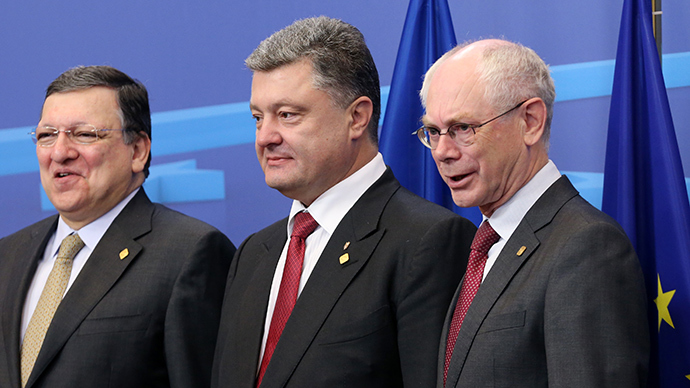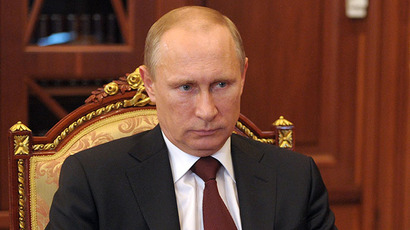5 facts you need to know about Ukraine-EU trade deal

Ukraine has signed the European Trade Association Agreement, the document that sent the country into a political frenzy when not signed eight months ago to this day. RT gives you the basics on how this will affect the economy of both from here on out.
1. What’s in the document?
The economic part of the pact signed between Ukraine and the EU will slash 98 percent of trade duties on the EU’s 28 member’s goods and 99 percent on Ukrainian products. The EU says it'll give Ukrainian markets greater access to Europe which is expected to give the country an economic boost, including more trade and job creation.
Ukraine hopes it will lead to full - fledged EU membership one day, but EU ministers say that isn’t happening anytime soon.
The treaty is a way for Brussels to gain political control over Kiev and in return, offer beneficial trade conditions.
Details on the transition period are such that Ukraine has 7-10 years to change product names already in use in the EU. Poultry from Ukraine will be regulated, as not to interfere with agriculture subsidies in the EU. Ukraine’s domestic auto industry will be protected by a 15 - year buffer period to catch up to the European competition.
Ukraine must also meet EU requirements on product and food safety.
2. How does it change Ukraine’s trade?
Joining the European Free Trade Agreement means Ukraine will gain in Europe, but lose in Russia, a risky move by newly - elected President Petro Poroshenko.
Ukraine gains access to Europe’s $17 trillion economy with 500+ million consumers. It will lose preferential treatment and access to Russia’s $2.5 trillion and 146 million consumer market.
Ukraine will save up to $500 million on lifted tariff and duty fees when trading with Europe, but it’s free trade access with Russia will be revoked.
Before trade can start, Ukraine has to go through mountains of paperwork, tweaking laws and legislation to comply with EU standards; this will take time and money.
Russia has repeatedly said Ukraine cannot have its cake and eat it too. Its choice to join up with the EU instead of the Russian - led Customs Union will have economic consequences. No more free-trade, possible new tariffs, and definitely no more discounted gas.
Last year, Ukraine exported goods worth $16 billion to Russia, nearly 25 percent of all total exports. Ukraine exported $17 billion to Europe the same year.
Russia has said it may be forced to block Ukrainian imports due to the fact they cannot vouch for their quality under EU law.

3. Will this help or hurt Ukraine’s GDP?
EU has one answer and Russia has another. The EU thinks in the long-run closer ties with Europe will bring Ukraine economic prosperity. Moscow predicts a short-term windfall of $30-40 billion in the next year. The EU says it will make up for any counter actions by Russia.
Ukraine’s economy is predicted to fall by 5 percent in 2014.
Russia’s Committee for Civil Initiatives, a think tank headed by former finance minister Aleksey Kudrin, estimates Ukraine’s decision to sign the economic part of the agreement will cost the country $33 billion per year, or 19 percent of GDP.
Ukraine’s National Academy of Sciences and its Institute of Economics and Forecasting predicts up to $8 billion in losses from Russian trade.
The Ukrainian currency, the hryvnia, has weakened to 11.89 against the US dollar, losing nearly 45 percent since January 2014, when it was pegged at 8.235 to the dollar.
A weak hryvnia could make Ukrainian goods more attractive in European markets, but a flood of European goods into Ukraine could also devalue products and hurt companies’ profits and revenue.
4. What are the costs for the EU economy?
The costs of Ukraine's participation in the Eastern Partnership may turn out to be too high not only for Ukraine but also for the EU. That’s because the budget of the European Union has been calculated for 7 years ahead and does not envisage any extra expenditures, while Ukraine’s economy needs billions to revive its economy, as ITAR-TASS cites Sergei Kulik, Contemporary Development Institute Director for International Research.
The man was among the first to make a research on the consequences of the EU - Ukraine association for the EU budget.
Currently Ukraine needs the estimated $85 billion to finance the current balance of payments deficit to ensure the economy's stable development in 2015-2018.
However, development needs require financing by an order of magnitude larger than that, Kulik said. Ukraine needs "$190 billion until 2018 to recapitalize the national economy and $300 billion to overcome structural disproportions in the economy accumulated in the past 20 years," the expert said.
The financing needs of Ukraine can be compared with the European Union's massive cash injections to overcome the sovereign debt crisis in South Europe.
"…the figures show that the inclusion of Ukraine into the Eastern Partnership program is an unbearable burden for the EU," Kulik concluded.

5. What about anti - EU movements in Eastern Ukraine?
Though Poroshenko was elected on a primarily pro-EU platform, not everyone in Ukraine wants closer company with the West.
Violence in Eastern Ukraine continues along with the backdrop of the trade deal, as people there still consider the government in Kiev illegitimate.
If Ukraine is the ‘bread basket of Europe’, Eastern Ukraine is the center of industry and infrastructure. Donetsk and Lugansk are both southeastern regions where anti-government groups continue to fight. Together, these regions account for 25 percent of the country’s exports.
Steel, ships, nuclear power, metals, airplanes, autos, machines, refineries, and appliances are all manufactured in the historically Russian-speaking southeast. To export these goods to Europe, the Kiev government will need to make peace.
Agriculture and service industry dominate business in the Western regions.














